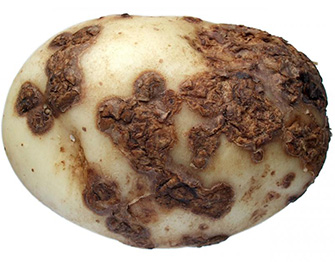Please click here to access the main AHDB website and other sectors.
- Home
- Knowledge library
- Common Scab
Common Scab
Common scab is an unsightly blemish disease of potatoes that can be especially problematic where irrigation is not available

Common scab is mainly caused by Streptomyces scabiei. The disease can affect any crop where tubers experience a dry surface during the critical stage of 3-6 weeks after tuber initiation. The disease has little effect on storability and does not develop in store.
Symptoms
Lesions may be circular or angular and may coalesce into large irregular areas. Severity can range from sparse colourless, corky lenticels to dark brown, raised or pitted scabs covering the tuber surface. Common scab might easily be confused with powdery scab. However, powdery scabs tend to be smaller, have a more round character and when coalescing they tend to merge as discrete eruptions rather than one large scab.Conditions
It is promoted by light free draining soils and dry weather in June/July, when rapid tuberisation takes place. Some cultivars of potato are more resistant to the scab (Melody, Cara) than others but none are immune.
Control
To prevent common scab developing in dry conditions you should irrigate every 4 to 6 days for 3 to 4 weeks after tuber initiation. The soil structure should ideally be fine to ensure contact between damp soil and tubers. Avoid increasing the pH of soil, plant clean seed and maintain long rotations.

